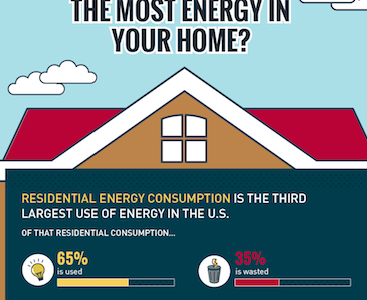Home’s Highest Energy Costs (and How to Lower Them)
by Uma Campbell, January 14, 2016-
When posed with the question, “what uses the most energy in our homes?” many people aren’t very surprised to learn that their HVAC (Heating/Ventilation & Air Conditioning) systems are the biggest culprits on most utility bills. Accounting for almost half (47%) of all energy costs, keeping our house comfortable year round tops this list, but other large draws come from appliances like hot water heaters (14%), washers & dryers (13%) and electric ovens (3-4%).
Lighting is another significant cost at 12%, while entertainment devices like televisions, cable boxes and and DVD players rank amongst the lowest. While most of these are considered basic necessities, how can we reduce our home’s energy consumption and save money in the process?
HEATING & COOLING
Again, most people are already aware that setting or programming thermostats to 68? in the winter and 78? during warmer months, will save on these costs, but performing a home energy audit can also help to greatly reduce these rates. While you can do this project yourself, many local utility companies offer these programs at no cost to homeowners and they will illuminate where costly hot and cold air is escaping. Inexpensive caulk, sealants and adding insulation can eliminate or reduce these leaks.
Speaking of insulation, if you have an older plumbing system and/or an aged hot water heater, adding wrap to exposed pipes and a blanket to this appliance will also help to take a chunk out of utility costs. Installing styrofoam pipe wraps and wrapping your hot water heater are both easy DYI projects that are also very inexpensive.
LIGHTING
Obviously turning off lights when not in use will reduce waste and can lower costs in some situations, but the savings on switching to CFL (Compact Fluorescent Lighting) and LED (Light Emitting Diodes) can save a bundle. When compared to regular, incandescent bulbs:
CFL (Compact Fluorescent Lights)
- Lifespan: 8,000 hours compared to 1,200 for regular
- Wattage: 13-15 watts compared to 60 watts (or more) for traditional
- Operating Cost: $76.65 per year compared to $328.59 for incandescent
LED’s (Light Emitting Diodes)
- Lifespan: 50,000 hours compared to 1,200 for regular
- Wattage: 6-8 watts compared to 60 watts (or more) for traditional
- Operating Cost: $32.85 per year compared to $328.59 for incandescent
In closing, while not using lights or appliances will cut costs, “vampire” devices are also draining many household energy budgets. When not performing their primary function, these items are left in standby mode and can easily add up to hundreds of dollars in wasted electricity every year. This infographic highlights savings when switched off:

About the author: Uma Campbell is a yoga instructor and freelance writer. She currently lives in Southern California. She enjoys writing about meditation, natural medicine, and energy saving tips. You can contact her at umajcampbell@gmail.com.


Comments are closed.